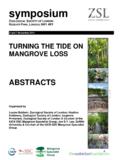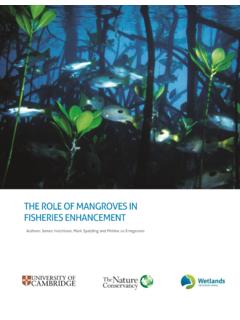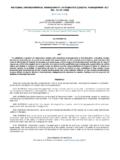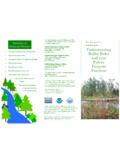Transcription of Mangrove Zone Ecology
1 1 Mangrove Zone Ecology Roy R. Lewis III, Laura L. Flynn Introduction The Mangrove zone consists of the intertidal coastal area lying between the spring high tide line and the spring low tide line in protected coastal waters encompassing a wide range of plant and animal communities. These communities are capable of tolerating extremes in inundation, drying, salinity, exposure, and storm damage and occur generally in the tropical and subtropical zones between latitudes 32 N and 38 S, gradually grading into salt marshes at both of these extremes as more frequent freezing events occur. Only recently, in the late 20th century, have the ecological communities within the Mangrove zone been acknowledged by scientists to have important ecological characteristics and by coastal zone managers to have important economic and social values to humans.
2 Prior to about 1970, they were generally treated as coastal swamps of little value to ecological processes or human society. With more enlightened attitudes and careful scientific studies it has been found that the Mangrove zone contains a great variety of both plants and animals of direct human benefit as medicines, food, and building materials and also provides protection from storms, water pollution abatement, and a critically important function in the global carbon cycle. General Overviews Macnae 1968 is the first comprehensive examination of Mangrove biology for a large area of the world (Indo-West-Pacific) but was published before the ecological value of mangroves was documented. Lugo and Snedaker 1974, building on the pioneer work of Heald and Odum 1970, synthesized the then-current science about mangroves with the first ecosystem approach and cautions about destruction and loss of fisheries associated with mangroves.
3 Chapman 1976 is considered the first published international compendium of previous discussions of the vegetation of the Mangrove zone with citations going back to 325 BC. Chapman took a very broad view of vegetation types within the Mangrove zone including marine algae, fungi, and herbaceous plants as well as the generally accepted forty or so species of woody vegetation as shrubs and trees. Tomlinson 1986 is a first edition emphasizing the botany of mangroves, and these constitute the major scientific publications about mangroves during that period. The Proceedings of the (First) International Symposium on Biology and Management of Mangroves (8 11 October 1974, Honolulu, Hawaii) were published in 1975 (Walsh, et al. 1975). Several similar symposia were held infrequently in subsequent years.
4 The modern era of Mangrove zone Ecology began with the publication of Hogarth 1999 and Saenger 2002 and continued with Alongi 2009, emphasizing ecosystem energetics and carbon pathways. Alongi, D. M. 2009. The energetics of Mangrove forests. Dordrecht, The Netherlands: Springer Science + Business Media. The most current summary of the energy flow patterns in and ecosystem functions of mangroves. Chapman, V. J. 1976. Mangrove vegetation. Vaduz, Liechtenstein: J. Cramer. The first truly international summary of Mangrove biology and physiology. An essential starting point. Heald, E. J., and W. E. Odum. 1970. The contribution of Mangrove swamps to Florida fisheries. Proceedings of the Gulf and Caribbean Fisheries Institute 22:130 135. 2 This was the first scientific documentation of the role of mangroves in supporting fisheries and led to many subsequent research efforts.
5 Hogarth, P. J. 1999. The biology of mangroves. Oxford: Oxford Univ. Press. One of the first of the modern syntheses of Mangrove biology that included ecological functions and proper acknowledgement of the similarities between ecological functions of Old and New World mangroves. Lugo, A. E., and S. C. Snedaker. 1974. The Ecology of mangroves. Annual Review of Ecology and Systematics 5:39 64. The first peer-reviewed synthesis paper documenting the ecological importance of Mangrove zone ecosystems on a worldwide basis. Macnae, W. 1968. A general account of the fauna and flora of Mangrove swamps and forests in the Indo-West-Pacific in Marine Biology 6:73 270. A very thorough review of the plants and animals using mangroves in the Old World, but with limited ecosystem functional analyses.
6 Robertson, A. I., and D. M. Alongi, eds. 1992. Tropical Mangrove ecosystems. coastal and Estuarine Studies 41. Washington, DC: American Geophysical Union. This is the first worldwide summary of knowledge about Mangrove Ecology with a number of essential papers. Saenger, P. 2002. Mangrove Ecology , silviculture and conservation. Dordrecht, The Netherlands: Kluwer Academic. The first modern summary of Mangrove Ecology including extensive data and discussion on Mangrove silviculture and management of forests for conservation. Tomlinson, P. B. 1986. The botany of mangroves. 1st ed. Cambridge Tropical Biology Series. New York: Cambridge Univ. Press. This book still stands as the definitive discussion of botanical aspects of the Ecology of the Mangrove zone. 419 pp. Walsh, D., S. Snedaker, and H.
7 Teas. 1975. Proceedings of the International Symposium on Biology and Management of Mangroves. 8 11 October 1974, Honolulu, HI. 2 vols. Gainesville: Univ. of Florida Press. Fifty-eight peer-reviewed papers from around the world. Still a classic early summary with papers of continuing importance. Journals Though no longer published, the journal Mangroves and Salt Marshes was published in three volumes between December 1996 and December 1999. It has now been incorporated into Wetlands Ecology and Management, one of the main journals in which papers on Mangrove zone management and restoration are currently published. Other journals where Mangrove papers are commonly published are Wetlands, Ecology , Ecological Applications, Restoration Ecology , Bulletin of Marine Science, and Estuarine and coastal Shelf Science.
8 Bulletin of Marine Science. 1951 . An international journal devoted to marine sciences with many important papers on mangroves. Now available free online. Ecological Applications. 1991 . A more recent series of journals published by the Ecological Society of America and devoted to applied Ecology . Ecology . 1920 . The premier journal on Ecology of world ecosystems, published by the Ecological Society of America. Estuarine, coastal and Shelf Science. 1975 . An international multidisciplinary journal that includes frequent papers on Mangrove science. Mangroves and Salt Marshes. 1996 1999. Published in three volumes between December 1996 and December 1999. It has now been incorporated into Wetlands Ecology and Management. Restoration Ecology . 1993 . 3 The journal of the Society for Restoration Ecology , in which papers on Mangrove management and restoration are published frequently.
9 Wetlands. 1981 . The journal of the Society of Wetland Scientists. Fewer papers on mangroves, but often has papers of related interest such as tidal marsh Ecology papers. Wetlands Ecology and Management. 1991 . The journal where most international papers on mangroves are published. Databases Online databases often supply up-to-date descriptions of projects and provide direct access to published materials as .pdf files. For example, the Mangrove Restoration website has over eighty free .pdf files of older Mangrove zone Ecology literature as well as more current publications. It is often difficult for Mangrove zone researchers and managers in less developed countries to access large libraries where free access to such literature may be provided. The nongovernmental organization (NGO) the Mangrove Action Projectis an international organization with overseas offices and many active projects described on its website.
10 Mangroves for the Future is also an NGO that has funded a number of projects on Mangrove management and restoration and provides free access to a number of reports on these efforts. National Geographic published a very comprehensive and well-illustrated international summary of Mangrove zone Ecology , Warne 2007. Description of mangroves and Mangrove habitats in the largest area of mangroves in North America including information about mangroves in the Florida Everglades can be found at the State of Florida Mangrove website. Both the Ocean Portal and Radford University sites provide detailed descriptions of Mangrove zone biomes around the world. It is important to note that all these sites are updated regularly and need to be revisited to look for new information on a regular basis. This is just a sample of the multitude of sites that can be found with routine searches.







